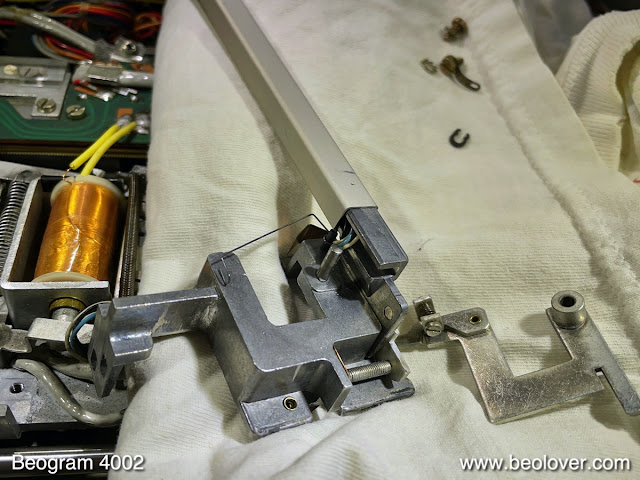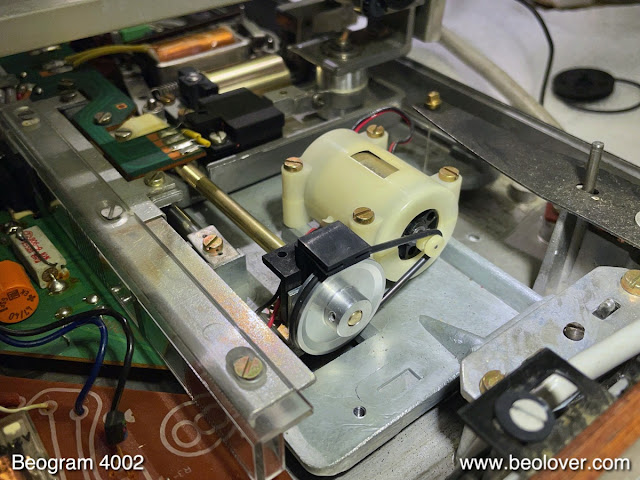This post describes the work that was performed on a Beogram 4002 (Type 5503), that I recently received. The original condition of the unit as received is described in this post. A separate post describes the restoration of the carriage position sensor. It needed a replacement housing, which is described here.
This shows the unit with the aluminum panels removed:
It was in unadulterated original condition, the best starting point for a complete restoration. On the cosmetic end, the keypad had delaminated, and the keypad itself showed the usual finger smudges that are a result from acids and fats interacting with the clear coat that is on the pads to give them their nice slightly tan look to contrast with the aluminum surfaces. Luckily, one of us Beolovers has figured out how to restore these keypads to a like-new look, and this Beogram will get such a keypad installed!
As usual I started with rebuilding the carriage mechanics:
This shows the extracted parts:
A closer inspection of the solenoid lever revealed the usual crack through the rivet hole. Also as usual someone already glued it back together:
Of course the Beolover has a part for this!...;-):
This shows the repaired lever:
I cleaned the parts with an ultrasonic cleaner and also restored the brass surfaces to their original shine:
This shows the repaired solenoid lever installed:
There is one more linkage that needs to be extracted and re-lubricated. It is only accessible by taking out the sensor arm. This shows the arms assembly from the back:
I removed the sensor arm and extracted the damper-to-tonearm linkage:
As usual, the small copper pad that helps the tonearm sliding back into its parallel position when it is laterally moved while up, came off, too. It is only held in place by a small piece of double sided tape, which is often degraded at this point in time:
I cleaned the tape off and glued it back in place with a dab of epoxy:
then I replaced the cracked plastic carriage pulley
with a nice new machined aluminum pulley:
then it was time to replace the tracking sensor light bulb with an LED assembly. the original bulb is located in the black housing in this picture:
I removed the original housing. Here you can see it in comparison with the LED assembly:
This shows the LED light source installed:
The next step was to focus on the AC platter motor and the large electrolytic motor and reservoir capacitors:
I removed all components and opened up the motor:
Then I immersed the motor housing with its sleeve bearings in motor oil and pulled a vacuum to re-infuse the bearings with oil:
After 24 hours the bearings were ready and I put the motor back together. Then I installed new capacitors held in place with a 3D printed adapter:
Another light bulb to replace is found in the sensor arm where it helps detecting the presence of a record. This shows the small sensor compartment pulled out from the end of the sensor arm. The small bulb can be seen in the compartment. Next to it is the LED assembly:
While I installed the LED assembly, I realized that the photo cell had come loose. It sticks in the back of the compartment to measure the reflected light from the platter if there is no record:
If the cell is loose, it needs to be carefully extracted that contact cement can be re-applied to its back and the top of the sensor compartment. This shows the cell:
After the contact cement had dried, I re-installed the sensor and very carefully pushed it into its small notch at the top of the compartment:
This shows the LED board in action. A warm-white LED makes sure that there is enough red light to make the B&O logo light up properly:
Two more light bulbs for replacement are located in the RPM trimmer panel where they illuminate the RPM scales. This shows the RPM panel with installed LED boards:
When I tested the LEDs, I noticed that the 33 RPM scale had a wavy white background:
This happens due to the heat that comes from the incandescent bulbs. Usually, this issue is limited to the 33 RPM adjuster, since most Beograms are rarely used to play singles at 45 RPM, and so the white background tape remains flat behind the 45 RPM scale. This shows the wavy original background after I opened up the compartment:
I replaced the backgrounds on both sides with some cut to size 3M white electrical tape:
After re-assembly, the background looked smooth and homogeneous:
Beolovely!
After this I moved on to restore the carriage PCB, which serves mostly to detect the carriage position. The 'Plexiglas ruler' that is mounted to the carriage gets moved through a gap formed by a light bulb (right side) and a photo resistor (left side). This shows the detector with the carriage removed:
The photo resistor housing had lost its mounting tabs. This is an often encountered issue since the plastic appears to get brittle over the years.
In the past I glued the sensor to the PCB, but this time I decided to design a new part, so one does not have to mess with glue anymore. The installation process is described in
this separate post. I also replaced the light bulb with an amber LED and a 3k resistor:
While I had the carriage up for the above repair I also replaced the solenoid transistor with a higher voltage rated C type. I already had to replace a few of them in the past, and so I made it part of the 'standard restoration process' as a preventative measure:
Now I focused on the main PCB, which is shown here in its original condition:
While it is lifted out, it is a convenient moment for replacing the transistors of the push-pull stage of the AC platter motor. This shows the new transistors installed:
On the main PCB I found a strange looking fuse F1. It was still intact, but had some depositit on the glass walls. This may have been the result of a near-blow where the filament reached a white glow and some metal got deposited on the glass:
This fuse is soldered into position, and so I needed to solder wires to the new replacement:
Then I replaced all the electrolytic capacitors, the power transistors and the RPM trimmers:
Next was the output PCB. This shows it in its original condition:
I replaced the muting relay and the electrolytic capacitor that gives the muting circuit its time constant. I also installed a (red) switch that allows connecting system and signal grounds in case there is a hum issue when connecting it to an amplifier:
As usual, I also replaced the main fuses in the small black fuse cabinet with new ones. They often have metal caps that have come loose from the glass bodies:
Then I adjusted the sensor transistor bias to get the prescribed 4V at the collector:
And then I tested the sensor response:
Then I adjusted the motor voltage and checked if the signal is a good sine wave:
If the waveform is distorted then either the voltage is too high, or there is an issue in the Wien oscillator circuit.
Since I worked on the carriage sensor, I also measured the sensor response: this shows the signal while the 45 RPM switch pattern moved though the sensor:
All good in the sensor department!
The next step was to qualify the platter drive with the BeoloverRPM device, which allows logging the RPM over longer periods of time:
This is the curve I measured over 24 hrs:
This is as good as it gets. But not surprising. So far I did not encounter an AC Type Beogram 4002 that had RPM instabilities.
On to replacing the cracked plinth guidance washers
and the deteriorated transport lock bushings.
My replacement parts are 3D printed from nylon, which promises they might last for a while.
Now it was time to do the adjustments. First I leveled the floating chassis and made sure that the platter and arms are in their proper positions relative to the aluminum panels. Once all that was in place, I adjusted the arm lowering limit
and calibrated the tracking weight:
Finally, I adjusted the tracking feedback:
Then it was almost time for a first test run, but I still needed to replace the corroded DIN5 plug with a nice gold plated all-metal plug:
Finally, after a deep clean of the aluminum plates and the installation of a rebuilt keypad, the moment had arrived to put a record on the platter! I selected one of my favorite George Benson records, his 1976 album
"Good King Bad" (CTI 6062). Of course, this album had been thoroughly ultrasonically cleaned on a
CleanerVinyl ProXL setup combined with a multi-frequency cleaner before play. Beautiful!:
I will now play this lovely Beogram 4002 a bit more to make sure it does not have intermittent issues and is stable. And then it will be time to send it to its new owner!


















































No comments:
Post a Comment
Comments and suggestions are welcome!